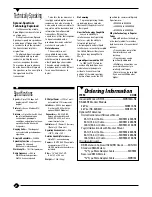
2
Spread-Spectrum
Technology Explained
Unlike conventional radio,
Spread Spectrum doesn’t stick to
one frequency.
During transmission, Spread-
Spectrum signals are spread over
a wide range of frequencies. Then
a receiver collects (de-spreads)
the transmissions into their
original form.
The Spread-Spectrum signal
is then tagged with a pseudo-
random code. Only the user’s
receiver recognizes this code.
The receiver knows in advance
how the transmitter will spread
the spectrum, so it can easily find
the signal and track the
transmission.
Speed —
Up to 115.2 kbps half-
duplex (up to 57.6 kbps full-
duplex)
Protocol —
Async, Modbus RTU
support
Distance —
Up to 20 miles (32.2 km)
line-of-sight, depending on
environment, geographic
conditions, and optional antenna;
up to 60 miles (96.6 km) with
2 repeaters
Hopping Code —
15 orthogonal
user-selectable pseudorandom
algorithms
Occupied Bandwidth —
230 KHz
Spreading Function —
Frequency-
hopping 112 channels
(96 channels international)
Word Length —
10-/11-bit maximum
Radio Frequency —
902- to
928-MHz spread spectrum;
No FCC license required
RF Output Power —
1⁄10 to 1 watt
(selectable in 1⁄10 increments)
Interface —
RS-232 (can support
2- or 4-wire RS-485 with the
optional RS-485 Modules)
Connectors —
RS-232: DB9;
Antenna: Standard-thread
SMA F; RS-485: 2- or 4-wire
screw terminal strip
Indicators —
P (Power), C (Carrier),
I (Data In), O (Data Out)
Operating Environment —
-40 to
+167°F (-40 to +75°C)
Relative Humidity Tolerance —
Up to 95%, noncondensing
Power —
12 VDC (24 VDC available
as special order); 115- or
230-VAC wallmount transformer
included
Size —
1.4"H x 5"W x 7.8"D
(3.6 x 12.7 x 19.8 cm)
Weight —
1.8 lb. (0.8 kg)
Technically Speaking
Specifications
Ordering Information
ITEM
CODE
Industrial Modem RF115 .................................MDR100A-R4
RS-485 RF Modem Module
2-Wire .................................................................MD3310-R2
4-Wire (RS-485/422).........................................MD3311-R2
Optional RF Antennas
Omnidirectional with Bracket Mount
25-ft. (7.6-m) Cable.............................MDR151-0025-R3
50-ft. (15.2-m) Cable...........................MDR151-0050-R3
100-ft. (30.4-m) Cable.........................MDR151-0100-R3
Yagi (Unidirectional) with Bracket Mount
25-ft. (7.6-m) Cable.............................MDR152-0025-R4
50-ft. (15.2-m) Cable...........................MDR152-0050-R4
100-ft. (30.4-m) Cable.........................MDR152-0100-R4
You may also need…
DB9 Extension Cable with EM/RFI Hoods........EDN12H
Standard SMA Male to
“N” Type Male Adapter Cable........................MDR153
Reversed SMA Male to
“N” Type Male Adapter Cable........................MDR154
To do this, the receiver uses a
locally generated replica pseudo-
random noise code, a received
code, and a receiver correlator to
separate only the desired coded
information from all possible
transmitters. (Think of the
correlator as a filter that responds
to signals encoded with a
pseudorandom noise code that
matches its own code.)
No Interference
The correlator is not
susceptible to man-made
interference or other noises—
whether natural or generated by
other Spread-Spectrum radios.
The code simply sounds like
background noise, so it’s difficult
for an unauthorized user to
detect.
No Jamming
To prevent jamming, the de-
spreading process spreads
(decreases) the power level of
other signals.
How the Technology Caught On
Low susceptibility to
interference and anti-jamming
features—plus the ability to
tolerate high levels of
electromagnetic and multipath
interference—are what prompted
the United States military to use
the technology during World
War II.
Spread Spectrum and the FCC
In 1985, the FCC let radios
based on a Spread-Spectrum
modulation method operate
without a license in certain
portions of the radio spectrum.
The three frequencies the FCC
specified for commercial Spread
Spectrum are:
• 902 MHz to 928 MHz
• 2400 MHz to 2483.5 MHz
• 5725 MHz to 5850 MHz.
Why the Technology is Popular
Today
Spread-Spectrum technology
is the ideal medium for wireless
data transmission for a number of
reasons:
• Transmissions remain free
from interference and
jamming.
• Transmissions can be
specifically addressed.
• Multiple conversations can
occur simultaneously in
relatively small areas.
• Data rates can be very high
if you use the 2400 band or
higher.




















